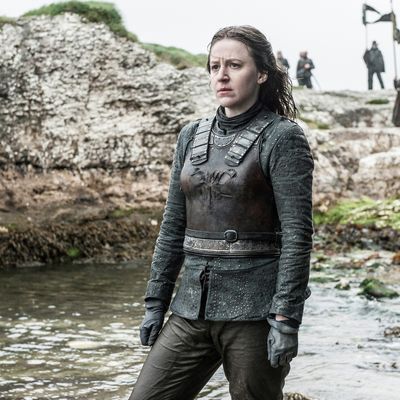
The Ironborn are assholes.
Yes, the social mores of a fantasy feudal society make nearly everyone on Game of Thrones an asshole, but even by the standards of their time and place, the residents of the Iron Islands stand out in Westeros for their moral monstrousness. The Ironborn worship the culture of the “old way,” a time when they were free to terrorize the western coast of the Seven Kingdoms, and they continue to rape and pillage wherever they can get away with it. Their tradition of taking “salt wives” is just a polite name for a crude form of sexual slavery, and they’re also the only people in Westeros to practice plain-old slavery, too, in the form of the thralls who live and die mining the ore that gives the islands their name. The Ironborn look down on anyone who does any actual work, or buys anything with money; real men, they say, pay the iron price for what they want — which is to say, they take it from someone who’s weaker than them. The Ironborn are terrible in almost every way that people can be terrible.
And yet, despite all this, they’re also the only people in Westeros with a cultural legacy of democracy: The kingsmoot, which, as the priest of the Drowned God informed Yara Greyjoy Sunday night, is the process by which the Ironborn choose their kings. The practice started thousands of years before the events of Game of Thrones, when the petty kings of each island would come together in a great council to choose the next High King of the Iron Islands. These gatherings take place after the death of the king of the Iron Islands — or when everyone agrees the current king is so terrible they need a new one — but they only be called by the drowned priests, the itinerant preachers who spread the good word of that Lovecraftian god throughout the islands.
Of course, it’s worth noting off the bat the kingsmoot isn’t true democracy: Only ships’ captains can take part, which mean no commoners, no thralls, and probably no women. (A few women have served as ships’ captains throughout Ironborn history, but it’s unclear whether any of them ever participated in a kingsmoot.) But then again, you could say the same thing about early American democracy, so who are we to judge, really?
The kingsmoot was the invention of an ancient priest, Galon Whitestaff, who decreed that Ironborn should not make war on each other, thus unfiying the fractious archipelago into a single kingdom ruled by a single monarch. According to tradition, any captain could put their name forward at a kingsmoot, as long as they were backed by three champions. What followed wasn’t entirely dissimilar to an old-timey presidential convention: Aspiring High Kings give a stump speech (often some variation of “Let’s kill these people and steal their stuff”) and then present the crowd with a gift symbolizing their candidacy. A kingsmoot lasts until a majority of captains agree on a candidate, which, as The World of Ice and Fire puts it, meant that these “unruly gatherings … oft went on for days, and in a few instances, far longer.”
Not every kingsmoot’s results have been considered constitutionally valid, however. Besides needing to be called by a priest of the Drowned God, It’s generally accepted that a kingsmoot requires every reasonable candidate to be in attendance. This rule has only only invoked once, after the death of King Urragon III Greyiron, whose sons called a kingsmoot while their brother was off being horrible somewhere else. Unfortunately for them, their gambit failed — the captains chose a guy called Urrathon Goodbrother instead, and his first act as High King was to immediately put those sons to the death. His second act was to institute a two-year reign of terror. (More like “Badbrother,” the Ironborn said, and so that became his nickname.) Eventually, though, the missing son Torgon Greyiron came back, and invoked the rule of Hey, Not Fair to challenge the results of the Kingsmoot. Since the people of the Iron Island were getting tired of the king killing everybody, they agreed, and thus Urrathon was violently hacked to pieces and Torgon proclaimed king in his place.
In George R.R. Martin’s novels, this was the beginning of the end of the kingsmoot, though it appears to be a continuous practice in the show. Since Torgon himself had been crowned without a ‘moot, nobody batted an eyelash when he named his own son as heir in his later years and began preparing the lad to rule. Once he reached old age, that son decided that he wanted to name his own heir too, choosing his nephew Urron. The priests of the Drowned God could see what was going on here, and insisted on a kingsmoot. I’ll let The World of Ice and Fire tell you what happened next:
Hundreds came, amongst them the salt kings and rock kings of the seven major isles, and even the Lonely Light. Yet scarcely had they gathered when Urron Redhand loosed his axemen on them, and Nagga’s ribs ran red with blood. Thirteen kings died that day, and half a hundred priests and prophets. It was the end of the kingsmoots, and the Redhand ruled as high king for twenty-two years thereafter, and his descendants after him. The wandering holy men never again made and unmade kings as they once had.
Sad!
And yes, if all the factional discord, backstabbing, and gasbagging didn’t tip you off, the kingsmoot can definitely be interpreted as an accidental preview of what might happen if we do in fact get a contested convention in Cleveland this year. But there’s bad news for Yara: If our current political landscape is any indication, the Ironborn may be thirsty for a charismatic shape-shifter who will make the Iron Islands great again. Have we seen any of those hanging out on any bridges recently?


